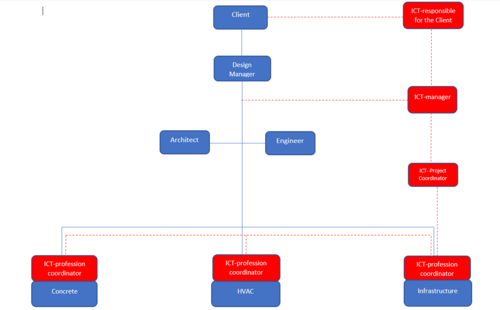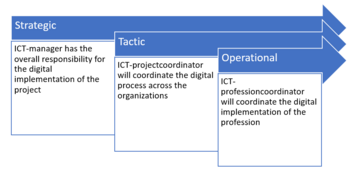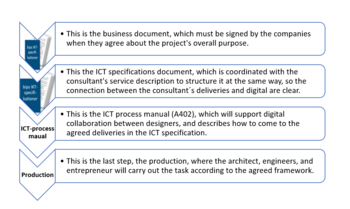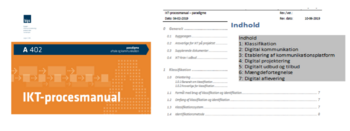ICT Agreement
Contents |
Abstract
In the construction industry happens a lot of activities and these activities are interdepended and since the construction industry has been changed a lot and becomes more digitized, so it’s important to make a clear agreement between the different actors. In this context, the purpose of this article is to examine how a better contractual relationship can be created between the various actors through digitization. This article will consider the digital tool (ICT agreement) and will examine the possibilities. With the use of ICT agreements in the construction industry, the opportunities will become greater and greater within digital workflows that support the construction process throughout. The purpose of using the ICT Agreement is to gather the separate agreement bases in one tool and use it as a management tool across interfaces and players in the construction industry. On this agreement basis, the ICT agreement will contribute to better control of the construction process. ICT stands for information and communication technology, the ICT regulation came into force in 2007, and much has happened since its inventions. There are several comprehensive documents that will cooperate with the ICT agreement. These documents are Description of Service (Building and Planning 2018), Organization and role, ICT-specification, and ICT process manual, which will support digital collaboration between designers. The following sections will define and describe the above documents in order.
Background
The idea with the ICT agreement was to have better control options in the early design phases, but gradually the focus has been on the role of the client and the contractors because the greatest values lie in the operation and maintenance of the building. Thereby, extensive work must be done in the construction industry to ensure a fundamental value of the building even after construction. This can be done using the digital tool (ICT Agreement), where all materials after execution will be passed to the operation and maintenance department. There are two kinds of ICT agreements in Denmark, (nr. 118) for public projects and (nr. 119) for general construction.
The ICT regulation
For buildings, the ICT regulation includes several requirements for the use of information and communication technology. The ICT regulation gives the client the opportunity to demand that the digital building objects be structured, classified, named, coded, etc. throughout the process. In addition, the client must require that the building objects be provided with the information and properties that are relevant to the subsequent operation and maintenance. The next section will describe and define these different requirements that the client/builder can apply during the building process
ICT coordination
The ICT coordination will give the client an opportunity to monitor whether the client requirements described with the various parties are complied with and it’s the client’s responsibility to insert an ICT responsible already from the beginning of the construction process, as it is extremely important that the communication through the digital world will function as a whole. The client must ensure that there is a coordination of the total ICT-application between all parties throughout the construction case. ICT coordination is about how the construction case should be organized and optimized, where the ICT use must be to the benefit of the individual participant for the construction case. The scope of ICT coordination must be determined by the size and complexity of the task and the number of parties that are up to the client to decide.
Handling digital construction objects
It is the client who demands that digital building objects be structured throughout the construction case, classified, named, coded, and identified uniformly in a specified level of detail. In addition, the client must require that the building objects be provided with the necessary information and properties, which are relevant for operation and maintenance. Other than that, the client must ensure that guidelines for the handling of digital building objects are maintained throughout the construction case
Digital communication and project web
It is the client who must demand a system for digital communication and the archive of relevant information during the construction case. In addition, the client must ensure, that a plan is prepared, and who or which part should update the system and what kind of information are available, and at what time. And a clear agreement, that the system is equipped with access control and log, and which file formats will be used, and which metadata will be associated with the individual file types.
Application of digital building models
For project competitions, the client in the competition program must require that the building models, level of information in relation to architectural, functional, and technical conditions is set out in more detail specific level of information. In the project competition, the client must also require, which kind of program the parties will use throughout the building process, and how the partner will structure them, and how the object-based building models will be submitted. All these requirements are depending on the character and complexity of the building.
Digital tender
The client must require that for invitations to tender for construction works digital invitations to tender and bids are applied. Tender materials must be structured in such a way that they must be easy and available through the use of the construction case, and thus to the relevant extent and the documents can be used digitally by the bidders in conjunction with their submission of a bid. And the client must also, ensure that the bill of quantities is included in the tender document and is relevant for each contract as well as the models are available to the bidder in IFC format. The documents must show an exact calculate of quantities and measurement.
Digital delivery of the building
The client and the operator must require about the digital delivery of the construction, and what information is relevant to be delivered. Information to be submitted for the operation and maintenance department is, documentation of the construction works, construction projects, operation, and maintenance plan, and how to manage the property in the future, moreover, the client must also ensure, that digital delivery of the construction project includes the agreements of advisers, contractors, and suppliers.
Digital information about identified shortcomings
The client must ensure that the digital information concerning the defect will be handled digitally. It must follow the structure of the building case's objects in building modeling that belongs to the classification. In addition, a procedure will be performed for the inspection, where the information concerning defect is included as an independent professional model in the object-based building model.
Description of Service: Building and planning 2018
The service description (building and planning 2018) is used as a basic agreement on consultancy in connection with construction and landscape project. This service description is designed with a view to defining the roles and distribution between client and consultants and between the individual consultants to have a clear agreement and the service description describes especially the responsibility of the project consultants/adviser, project manager, project management, and the professional supervision tasks and also determines the consultant's responsibility, how to coordinate the collaboration with the contractors after entering into an agreement with them. This service description will contribute in collaboration with the ICT agreement to have better control of the construction process to reduce the challenges, which will arise during and after the building process between the various actors. Finally, this collaboration will help to deliverer a successful project to the client.
ICT project roles
The ICT project roles (a305) are developed by the bips. The purpose of this publication is to achieve a better value with digital collaboration and a common understanding of the project roles and project organization to ensure a successful project’s digital implantation. The publication defined a common condition and describes the roles that are in an ICT collaboration and it provides the opportunity to distribute responsibilities and tasks that, the involved roles must-have during the process. This publication is used by the companies such as architect, engineers and especially the client. Their roles will be described in the following sections.Strategic
The ICT-manager has the overall digital responsibility for the implementation of the project. The responsibility of the ICT manager is clarified in the service description for building and planning 2018 as well. The manager can delegate the responsibilities to project coordinators if the manager can feel more pressured during the process. The manager's overall responsibility is to ensure that the intended value will be submitted by the digital process. Some of these responsibilities are: Responsible for implementing the project’s ICT specification and ensure that all parts are doing it. Responsible that the ICT technical specification is performed, approved, and used in the implementation of the construction process. Responsible for describing the digital material including classification and identification.
Tactic
The ICT project coordinator is the tactical person during the construction process. The project coordinator's overall responsibility is to coordinate the digital process across the organization. The coordinator handles quality assurance, coordination, dissemination of guidelines, etc. The coordinator works closely with the ICT project manager and professioncoordinator. Some of the project coordinators responsibilities are:
- Responsible for the establishment, administration, and dissemination of project web and document management.
- Responsible for holding and coordinating interdisciplinary coordination meetings in connection with digital collaboration.
- Responsible for a process for quantity extraction for calculations and quotation lists.
Operational
The professioncoordinator has the responsibility to coordinate the subject’s digital implementation of the construction process. The professioncoordinator works closely with the project coordinator. Here are some of the responsibilities
- Dissemination of the project's digital deliveries within its own subject.
- Coordination of the digital processes within own subject. And to ensure that the subject's deliveries are in line with the project's ICT specifications.
- Ensure the subject's digital production of drawings and models.
ICT specifications (A 102)
When all actors are agreed with the client about the construction process and use of the digital tool (ICT agreement) then they will use this ICT specification to define the scope of ICT services and create the optimal basis for the digital collaboration on the project for the benefit of all parties. This document is used for the digital part of the contractual basis between the client and the consultants etc. There are three models of ICT specifications, which can help the actors to specify the digital deliveries clearly for the benefit of the digital collaboration and well-defined data handling. This document is also consisting of instruction, a guide, and a collection of some examples to describe and show how the document should be used.
ICT process manual (A 402)
This process manual (A 402) is only supporting the digital collaboration and deliveries between the architectures, engineers, contractors, and suppliers. This document is used to elaborate on the individual point, where the actors will explain how they will manage the process, how they will communicate, and which kind of machines will be used, so every part has already known about it. This helps that will be no disagreements during the project between the actors and the actors can most effectively meet the requirements. The document can be easily updated if the number of participants changes in the form of collaboration as well as the system during the project process. When all these things are done, then the production process will begin. As sees below, this process manual has the same number of requirements as the ICT agreement describes and all these requirements must be completed. This ICT agreement is relevant when there are many actors involved in the project and the cost is over 5 million kroner.
Barriers of ICT in Construction Industry
The use of ICT agreement in the construction industry will give the best communication systems and technical decision support systems, but this digital tool is also expensive to invest, high cost of professionals to the employee, high cost of maintenance, high cost of software programs, high cost of training, system malfunction, virus attacks, technological barriers such as difficulty with the new technologies, etc (Mutesi and Kyakula, 2011). All these problems can increase the cost of the project for the client, which is not interesting.
Annotated Bibliography
References
Aftale og kommunikation | Digitale Værktøjer | Molio. Molio. Published 2021. Accessed February 23, 2021. https://molio.dk/produkter/digitale-vaerktojer/aftale-og-kommunikation Retsinformation. Retsinformation.dk. Published 2021. Accessed February 23, 2021. https://www.retsinformation.dk/notfound It is a center for the danish common state legal information system
IKT-bekendtgørelsen. Bygst.dk. Published 2013. Accessed February 23, 2021. https://bygst.dk/byggeri/ikt/ikt-bekendtgoerelsen/ This the Danish Building Authority is a real estate company and developer for the state and the universities (Mutesi and Kyakula, 2011).An article about ICT agreement in the Construction in kyambogo university Uganda
Bekendtgørelse om anvendelse af inf komm tekn i offentligt byggeri.pdf/This is the ICT regulation in Danish, which describes the overall requirements.
a305_ikt-projektroller_20151102.pdf/this documents describe the role of the project manager, project coordinator, and project professions coordinator
a104_dokumenthaandtering_2015-06-16_r1.pdf/this document describes how the actors should deliver the tasks



